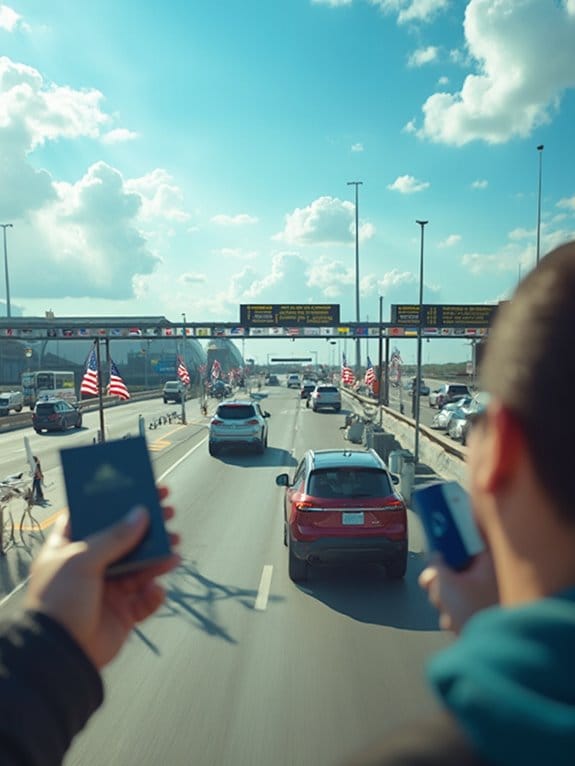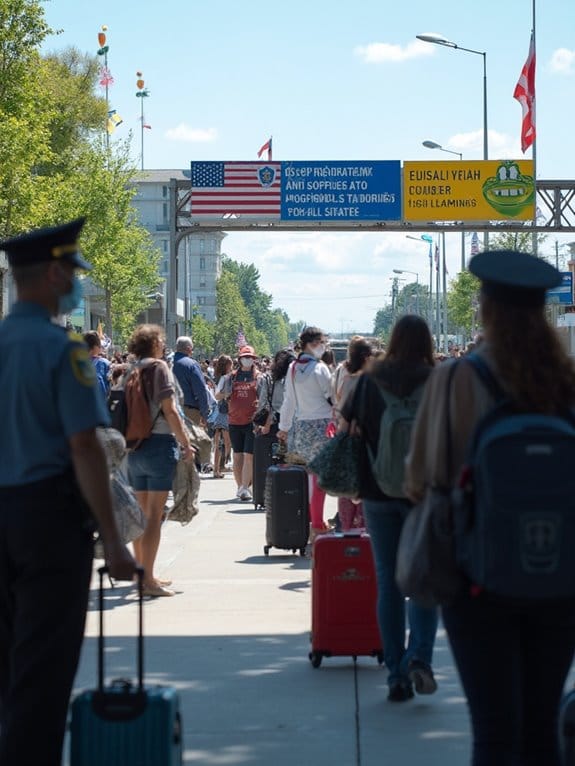Crossing the US-Canada border is super easy these days! You don’t need to worry about COVID vaccinations or pre-test shenanigans. Just grab your valid passport or enhanced ID, and you’re golden! While masks aren’t a must, they’re recommended in crowded spots—think busy border lines. You can totally skip the ArriveCAN app, but it might speed things up at customs. Oh, and if you’re traveling with kids, make sure you have their birth certificates handy. It’s all about keeping it smooth and stress-free, so buckle up and let the journey begin—you’ll discover even more handy tips along the way!
Key Takeaways
- No COVID-19 vaccination or pre-boarding tests are required for travelers crossing the US-Canada border.
- There are no quarantine requirements upon arrival in Canada for travelers.
- Wearing masks is recommended in crowded spaces, but not mandatory.
- ArriveCAN is not required but can expedite customs and immigration processes.
- Travelers must carry valid passports or identification as per their citizenship status.
Current Entry Restrictions
As of now, there are no COVID-19 vaccination requirements for travelers entering Canada, regardless of whether you’re arriving by air, land, or sea. That’s right! You can pack your bags without worrying about proof of vaccination. Plus, you won’t need to take any pre-boarding tests, which means more time enjoying those last-minute holiday snacks instead of waiting in line.
When you cross the border, there’s no quarantine waiting for you either. You can step out into Canada and breathe in that fresh air immediately. While health checks and masks on planes and trains aren’t mandatory, it’s still a good idea to wear a well-fitted mask, especially if you’re in a crowded space. If you’re feeling under the weather, it’s best to skip the trip and notify the staff if you start feeling sick during your travel. Additionally, travelers are encouraged to check local health directives to ensure compliance with any regional guidelines.
Oh, and even though using ArriveCAN isn’t required, it can save you time at the border by letting you submit your customs and immigration details ahead of time. So, keep up with those entry procedures and travel updates to guarantee a smooth journey!
Required Travel Documents

When planning your trip across the US-Canada border, it’s crucial to have the right travel documents readily available. Imagine arriving at the border, excited for your adventure, only to realize you don’t have the necessary paperwork! For Canadian citizens, a valid passport or an enhanced driver’s license works wonders. If you’ve got a NEXUS card, that’s a bonus for speedy travel.
Now, if you’re a U.S. citizen, grab your valid passport, or an enhanced ID; they’re your golden tickets, too! Permanent residents, remember to bring your green card and passport from your home country. And if you need a visa? Be sure to have that visitor visa or Electronic Travel Authorization (eTA) ready. Additionally, biometric screening requirements may apply based on your nationality, so it’s essential to check this before your trip.
For students and workers, don’t forget your study or work permit alongside your passport. It’s all about meeting those passport requirements and having your travel documentation in order.
Lastly, carry proof of funds for your stay and maybe a little evidence of your ties back home—those help you look like a responsible traveler. So, pack those documents and get ready for some border-crossing fun!
Health and Safety Recommendations

Maneuvering the US-Canada border during your travels means staying informed about health and safety recommendations. While the COVID-19 entry restrictions have been lifted, it’s still smart to stay vigilant about your health. Even though you don’t need to show a negative test or proof of recent infection anymore, consider the vaccination benefits. Getting vaccinated not only protects you but also helps keep others safe, making your travel experience smoother and more enjoyable. As of October 1, 2022, all COVID-related border restrictions have been lifted, allowing for easier travel between the two countries.
Remember, non-essential travel is back on the table, and that’s great news! You can explore new places without the worry of quarantine. However, always keep travel safety in mind. Washing your hands, wearing a mask in crowded places, and staying away from sick folks can go a long way in keeping you healthy.
Lastly, keep an eye on health guidelines as they can change. Health authorities are still monitoring the situation post-border crossing, so staying informed is key. So, pack your bags, bring your sense of adventure, and get ready to enjoy your trip while keeping safety front and center!
Special Cases for Travelers
Managing special cases for travelers crossing the US-Canada border can be essential for ensuring a smooth journey. If you’re heading over for essential travel, like delivering food, healthcare, or life-saving medicines, you’ll want to know the ins and outs of the entry requirements. For instance, if you’re a Canadian citizen traveling by land or sea, remember to pack your passport or an enhanced driver’s license.
Got kids under 16? Don’t forget their birth certificates or citizenship certificates. And if you’re a dual citizen, carrying both Canadian and U.S. passports can really speed things up at the border, making your life a little easier. Additionally, be aware that non-resident travel has significantly decreased since the pandemic began, which may affect wait times and border processing.
Also, keep in mind that if you’re traveling with a school group, you’ll need written consent from a parent or guardian. It’s a good idea to check in with the nearest diplomatic mission if you’re unsure about temporary travel documents.
With a little prep and understanding of these special cases, you can make your border crossing less stressful. So, get ready for your trip, and remember, a smooth journey is just a few documents away!
Local Requirements and Guidelines

Although traveling across the US-Canada border has become easier since the removal of COVID-19 restrictions, it’s still important to stay informed about local requirements and guidelines. You won’t need to show proof of vaccination or take pre-board tests anymore, which is a relief! However, if you’re feeling under the weather, it’s best to skip the trip altogether. Nobody wants to be that person spreading germs, right?
When you arrive, keep in mind that while health checks and masks aren’t required, wearing a mask is highly recommended, especially in crowded places. You might even want to use ArriveCAN, although it’s not mandatory; it can help speed up your customs and immigration process. It’s worth noting that crossings into the U.S. were down 25% in 2023 compared to the 2019 baseline, indicating the lasting impact of the pandemic on travel habits.
You’ll notice that travel behavior has shifted a bit since the pandemic. Border policies have changed, and some areas still feel the effects of fewer visitors from Canada. With these updates, you can navigate your journey with ease and confidence. So, pack your bags, stay informed, and enjoy your cross-border adventures! Remember, a little preparation goes a long way in making your travels smooth and enjoyable. Happy travels!
Frequently Asked Questions
Are There Any Fees for Crossing the Us-Canada Border?
You might think crossing the US-Canada border is costly, but there aren’t general fees. However, be aware of potential travel documentation fees and customs user fees that could apply, depending on your circumstances.
Can I Bring Food or Plants Into Canada?
You can bring food into Canada, but there’re food restrictions to follow, like limits on meats and fruits. As for plants, you must declare them, adhering to specific plant regulations to avoid penalties.
What Should I Do if I Lose My Travel Documents?
If you’ve lost your passport, panic might set in. First, report it immediately to the authorities. Then, start the document replacement process. Don’t forget to file a police report; it’s essential for recovery.
How Do I Report a Border Violation?
To report a border violation, follow the reporting procedures provided by border enforcement. You can use the online form or call the Border Watch Line. Provide details about the suspicious activity for effective reporting.
Is Travel Insurance Recommended for Crossing Into Canada?
Maneuvering the journey to Canada without travel insurance is like sailing without a life raft. You’ll want policy coverage that guarantees you’re protected, enjoying travel insurance benefits like medical expenses and trip cancellations, just in case.





